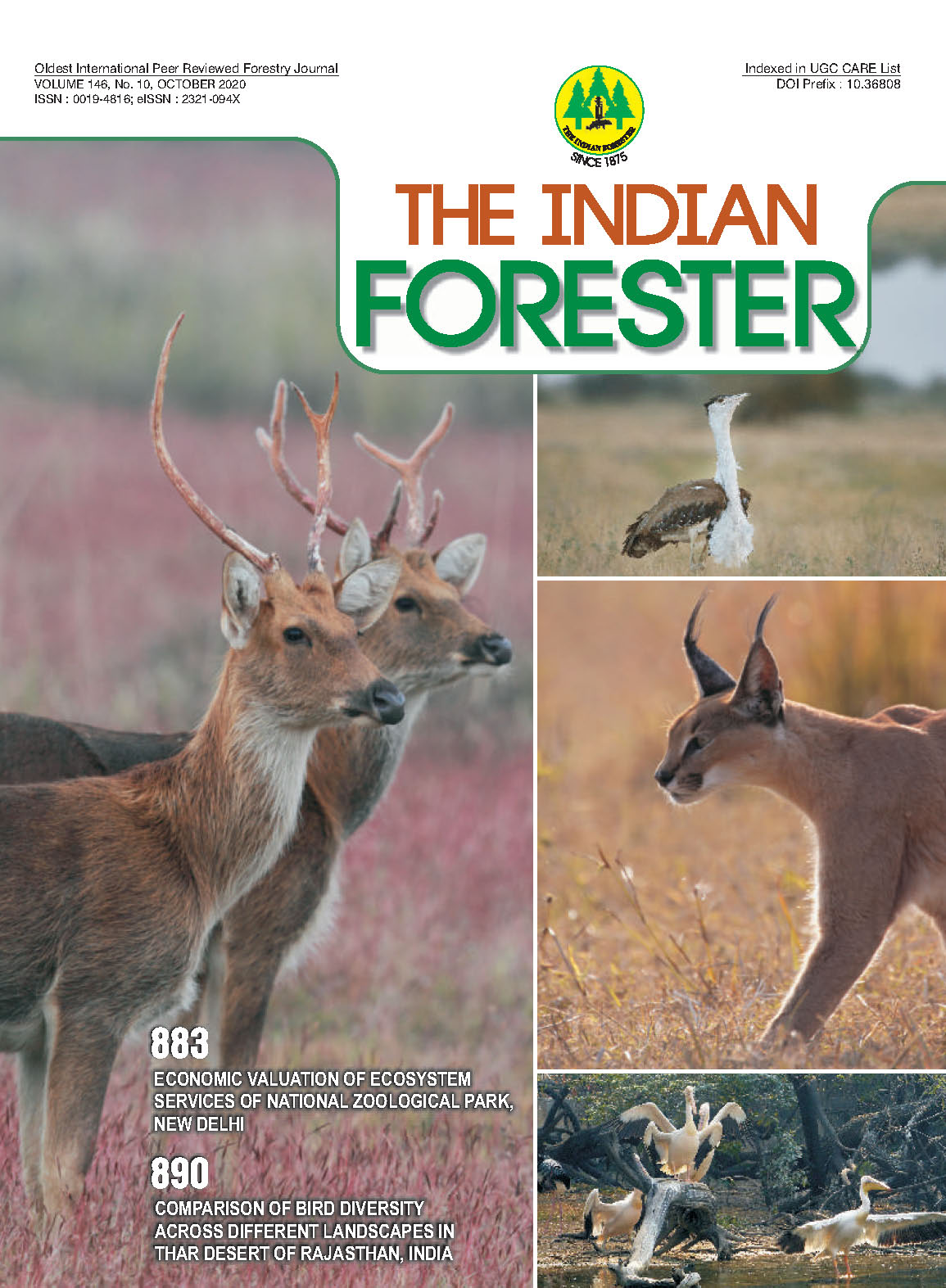Assessment of Protected area Management effectiveness of Sikkim, Eastern Himalaya, India
DOI:
https://doi.org/10.36808/if/2020/v146i10/155427Keywords:
Management Effectiveness Evaluation, Management Planning, Northeast India, Sikkim, Himalaya.Abstract
Globally protected areas (PAs) are considered as the cornerstones of biodiversity conservation. In recent years, there has been a growing concern among PA professionals to assess the management effectives o f PAs. The present study has been carried out for the evaluation o f PAs of Sikkim by applying IUCN Protected Area Management Effectiveness (PAME) framework with little modifications. There are eight PAs in Sikkim, which have been evaluated through this process during 2014-2015. The resultindicates thatPAs ofSikkim have an overall average evaluation score of55%, Khangchendzonga National Park being the highest score o f 62.50% and FambongLho Wildlife Sanctuary being the lowest score o f 46.67%. Four PAs o f the state are rated in 'good' category and remaining four are rated in 'fair' category. This exercise reveals that PA Network of the state is better placed as far as community support, protection, human wildlife conflicts and landscape integration are concerned. However, quality o f management plans and capacity o f field staff for wildlife management are critical areas which need to be addressed on a priority basis. The study provides an insight about strengths and weaknesses of the management and possible ways forimprovement o fPAs. The study also tries to look at the overall issues ofPA management and what policy level and institutional reforms are needed to strengthen the biodiversity conservation initiatives o f the State.References
Arnawatia M.L. and Tambe S. editors (2011). Biodiversity of Sikkim, Exploring and Conserving a Global Hotspot. Information and Public Relations Department, Government of Sikkim, Gangtok.
Bhardwaj A.K., SrivastavA., SathyakumarA., Ansari N.A. and MathurV.B. (2015). Management Effectiveness Evaluation (MEE) of National Parks and Wildlife Sanctuaries of Sikkim, Process & Outcomes. Department of Forests, Environment and Wildlife Management, Govt, of Sikkim and Wildlife Institute of India, Dehradun, Uttarakhand
Brooks T.M., Mittermeier R.A., da Fonseca G.A.B., Gerlach J., Hoffmann M., LamoreuxJ.F., MittermeierC.G., Pilgrim J.D., Rodrigues A.S.L. (2006). Global biodiversity conservation priorities. Science, 313: 58-61
Chape S., Harrison J., Spalding M. and Lysenko I. (2005). Measuring the extent and effectiveness of protected areas as an indicatorfor meeting global biodiversity targets. Philosophical Transactions of the Royal SocietyBioiogicai Sciences, 360(1454): 443-455.
Coad L., Leverington F., Knights K., Geldmann J., EassomA. etal. (2015). Measuring impact of protected area management interventions: Current and future use of the global database of protected area management effectiveness. Philosophical Transactions of the Royal Society Biological Sciences, 370(1681): 2014-0281.
FSI (2019). India State of Forest Report, Forest Survey of India, Ministry of Environment, Forest and Climate Change, Government of India. 16(11): 233-241
Hockings M. (2003). Systems for assessing the effectiveness of management in protected areas. Bioscience, 53: 823-832.
Hockings M., Stolton S., Leverington F., Dudley N. and Courrau J. (2006). Evaluating Effectiveness: A Framework for Assessing Management Effectiveness of Protected Areas. 2ndedition.
Gland, Switzerland and Cambridge, UK: IUCN. xiv+105 pp.
Jepson P., Momberg F. and van Noord H. (2002). A review of the efficacy of the protected area system of East Kalimantan Province, Indonesia. NaturalAreasJournai, 22: 28-42.
Krishna A.P., Chetri S. and Singh K.K. (2002). Human Dimensions of Conservation in the Khangchendzonga Biosphere Reserve, The Need for Conflict Prevention. Mountain Research and Development, 22(4): 328-331
Lacerda L., Schmitt K , Cutter P. and Meas S. (2004). Management effectiveness assessment of the system of protected areas in Cambodia using WWF's RAPPAM methodology. Ministry of Environment, Biodiversity and Protected Areas Management Project, Phnom Penh, p 27
Li D., Zhou J., Dong K., Wu B. and Zhu C. (2003). China: management effectiveness assessment of protected areas in the upper Yangtze ecoregion using WWF's RAPPAM methodology. WWF, Gland, p 25
Lu D.J., Kao C.W. and Chao C.L. (2012). Evaluating the Management Effectiveness of Five Protected Areas in Taiwan Using WWF's RAPPAM. Environmental Management, 50: 272. https://doi.org/10.1007/s00267-012-9875-9
Margules C.R. and Pressey R.L. (2000). Systematic conservation planning. Nature, 405: 243-253.
MathurV.B., Gopal R., Yadav S.P., Negi H.S. and Ansari N.A. (2014). Management Effectiveness Evaluation (MEE) of Tiger Reserves in India: Process and Outcomes. National Tiger Conservation Authority and Wildlife Institute of India, Dehradun, 144p.
MathurV.B. and NayakA.K. and Ansari N.A. (2019). Fourth Cycle of Management Effectiveness Evaluation (MEE) of Tiger Reserves in India, 2018. National TigerConservation Authority and Wildlife Institute of India, Ministry of Environment, Forest and Climate Change, Government of India. P. 212
MathurV.B. and Ansari N.A. (2018). Management Effectiveness Evaluation (MEE) of National Parks and Wildlife Sanctuaries in India. Process and Outcomes, 201718. Wildlife Institute of India, Dehradun
National Wildlife Database, (2020). National Wildlife Database Cell, Wildlife Institute of India, Dehradun, Uttarakhand, India
Sushila C.N. (2006). Nepal: managementeffectiveness assessment of protected areas using WWF's RAPPAM methodology. WWF Nepal Program, Kathmandu, p 33
Tshering K. (2003). Bhutan: management effectiveness assessment of four protected areas using WWF's RAPPAM methodology. WWF, Gland, p 27
UNEP-WCMCand IUCN. August (2020). Protected Planet: The World Database on Protected Areas (WDPA), August 2020 version, Cambridge, UK: UNEP-WCMC and IUCN. https://iivereport.protectedpianet.net/chapter-2
Downloads
Downloads
Published
How to Cite
Issue
Section
License
Unless otherwise stated, copyright or similar rights in all materials presented on the site, including graphical images, are owned by Indian Forester.





